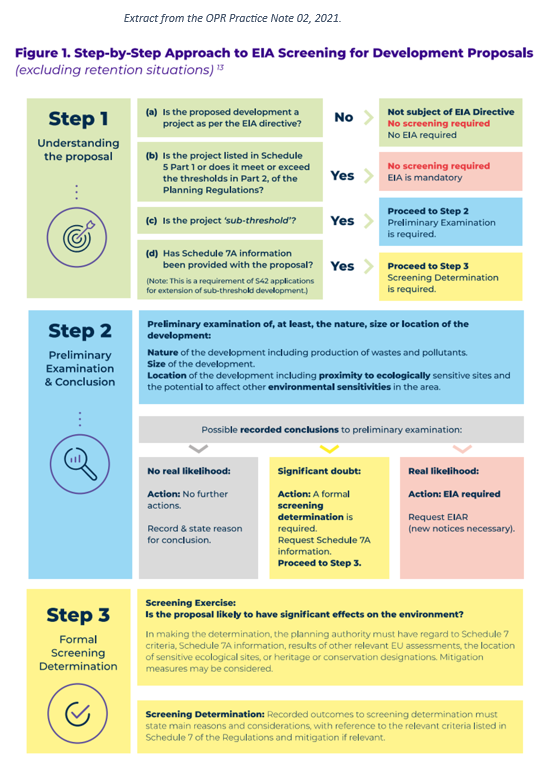Environmental Impact Assessment (EIA) comes from the European policy (EIA Directive) which aims to ensure a high level of protection for the environment and human health. Before planning permission is granted, the Directive requires that, if applicable, the project’s potential for significant effects on the environment be evaluated. In Ireland, this is carried out through EIA and EIA Screening processes, depending on the type of project proposed. According to the Environmental protection agency (EPA), ’Environmental impact assessment (EIA) is the process of examining the anticipated environmental effects of a proposed project – from consideration of environmental effects at the design stage, through consultation and preparation of an Environmental Impact Assessment Report(EIAR), evaluation of the EIAR by a competent authority and the subsequent decision as to whether the project should be permitted to proceed.’
Whereas, an EIA Screening Determination is a process which is ‘carried out by the planning authority to determine whether the proposal is likely to have significant effects on the environment and as such, whether an EIA must be carried out’ as defined by the office of the Planning Regulator (OPR). This process should take account of the impact of the whole project in question including, where relevant, subsurface and underground impacts, construction and operational activities and if relevant demolition phases.

Who is responsible for conducting an EIA Screening Determination?
An EIA Screening Determination is undertaken by the competent authority, which can be the planning authority (31 local authorities)and An Bord Pleanála, the Environmental Protection Agency (EPA) or other state bodies. The screening process may involve either a ‘preliminary examination’ of the likelihood of significant effects or a ‘formal screening determination’ depending on whether or not an EIA Screening Report has been provided with the proposal. Generally, to facilitate the screening exercise, a developer must arrange for an EIA Screening Report to be prepared and submitted to the competent authority.
The proposed project will then be assessed having regard to:
- criteria listed under Schedule 7 of the Regulations;
- EIA Screening Report (also known as a Schedule 7A report);
- any mitigation measures proposed;
- preliminary verifications or assessments (if available); and
- location of sensitive sites.
Once the assessment has been completed by the competent authority, a Determination will be made as to whether or not an EIA is required to be prepared and submitted. This Determination is not reversible during the planning application process.
What is the legislative context?
The relevant legislation on EIA is set out under EU Directive 2011/92/EU (European Policy), as amended by 2014/52/EU (“the EIA Directive”). Annex I lists developments for which EIA is mandatory and Annex II lists projects which require a determination of their likely significant effects. Criteria to determine whether a sub-threshold development should be subject to an EIA is set out in Annex III.
These annexes are broadly transposed into Irish legislation under a variety of Acts and Regulations, such as Schedule 5 of the Planning and Development Regulations 2001 (as amended). Outside the project types listed within the Planning and Development Act and Regulations, other legislation can trigger the requirement for an EIA, such as the Roads Act 1993 (as amended) and the Roads Regulations 1994, and so on.
What development types trigger an EIA/EIA Screening?
The first step to determining whether an EIA or EIA Screening Determination is required is by examining legal thresholds and reviewing the likelihood of significant effects on the environment arising from the proposed project.
A list of development types that trigger an EIA or EIA Screening is included in Part 1 and Part 2 of Schedule 5 of the Planning and Development Regulations 2001 (as amended). The OPR has identified the following three typical scenarios which could arise when your proposed project is checked against the project types listed in Schedule 5:
- If the proposed project is of a class listed in Schedule 5, Part 1 or Part 2 and meets or exceeds the relevant threshold, or where no threshold applies, a mandatory EIAR is required.
- If the proposed project is of a class listed in Schedule 5, Part 2 but does not meet or exceed the relevant threshold, it is a ‘sub-threshold development’ and must be screened for EIA.
- If the project is not of a class listed in Schedule 5, Parts 1 and 2, it is not ‘sub-threshold development’, and no EIA or EIA screening is required.

What information should be contained in an EIA Screening Report?
The content of an EIA Screening report is set out under various pieces of legislation. For the purpose of a planning application seeking development consent under the Planning and Development Act 2000 (as amended), Schedule 7A of the Regulations applies, which requires key information relating to your proposed project to be provided for the purposes of screening sub-threshold development, such as:
- a description of the proposed development (including its characteristics, and location);
- description of aspects of the environment likely to be significantly affected; and
- a description of any likely significant effects (including its types and characteristics).
Our Services
TOBIN’s Environment & Planning division provides services from our experienced team of Environmental Scientists, Planners, Project Managers and Engineers to undertake an extensive range of projects. We have significant experience and involvement in EIA Screening policy and regulation and can advise our clients on the initial stages of a project’s lifecycle from project management to development design, assessment and planning.



